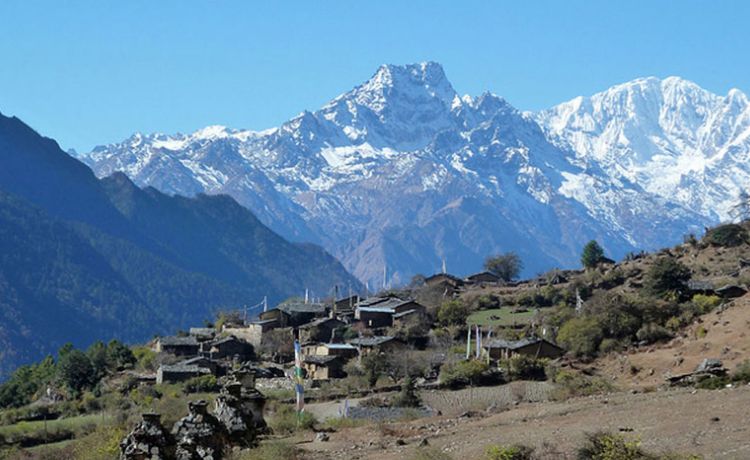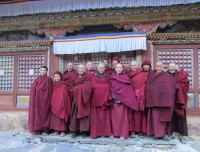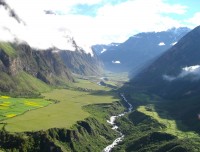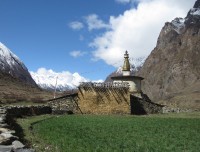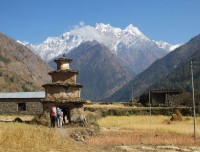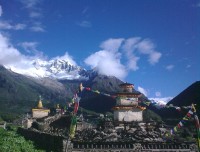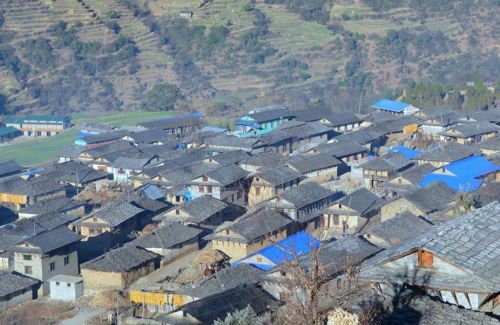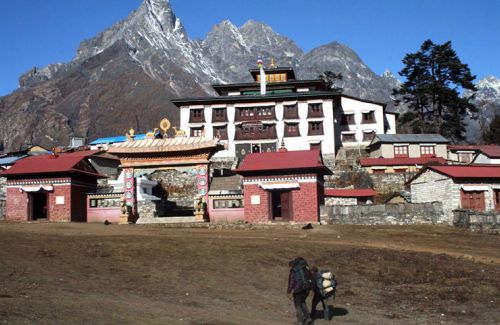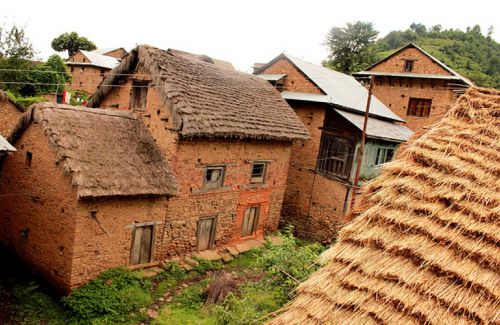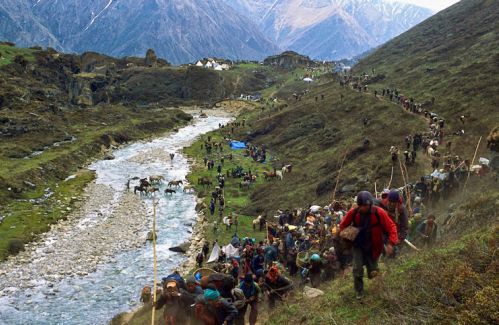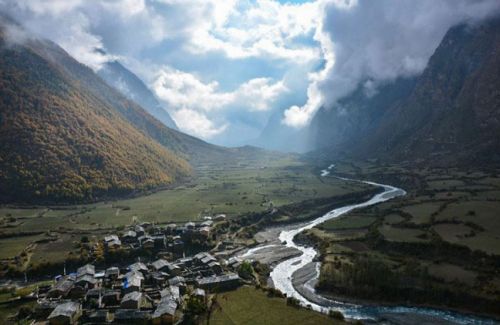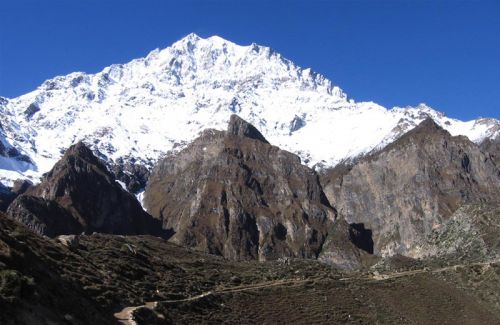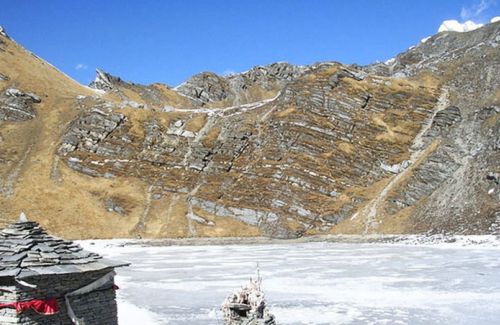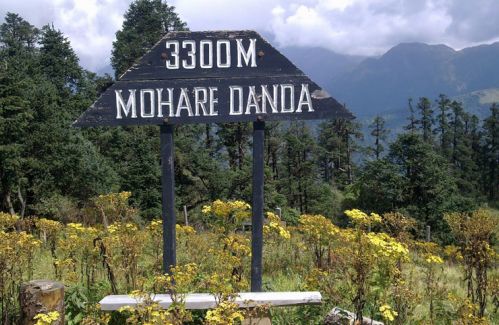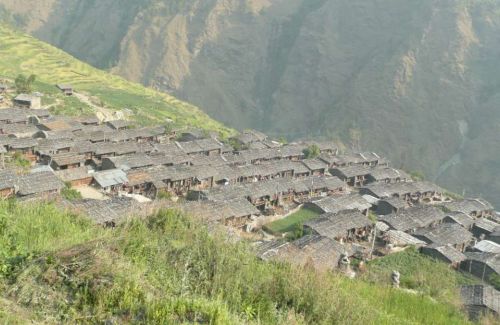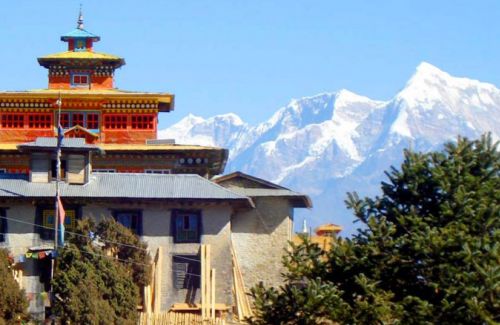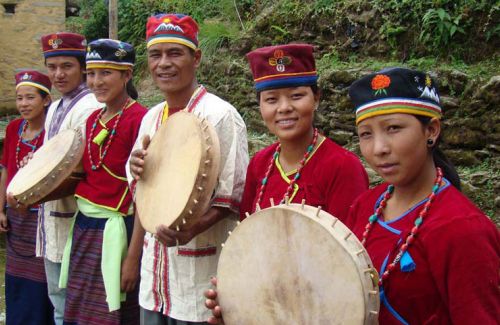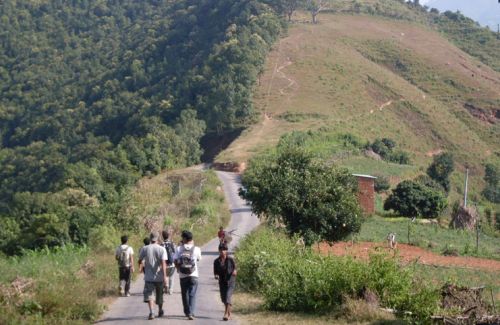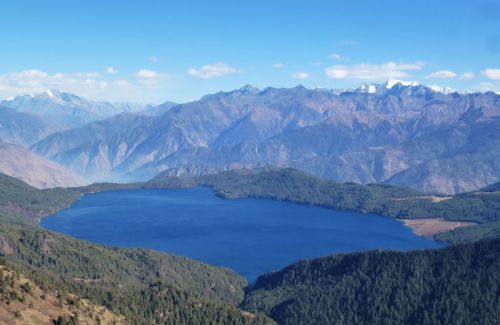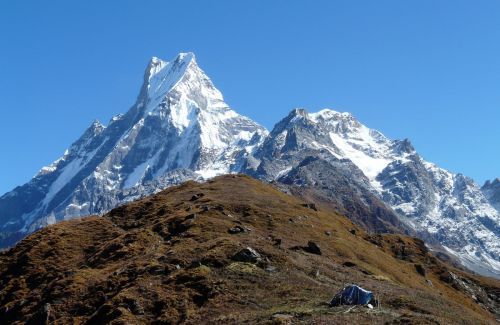Tsum Valley Trekking
- Duration24 Days
- Max. Altitude4,200 m
- Starts FromUSD 1950
Destination:Nepal
Trip Grade:Moderate (**)
Meals:Breakfast + Lunch + Dinner
Transportation:Private Vehicle
Accommodation:Lodge
Trekking Region:Manaslu Region
Show All
Tsum Valley is the hidden treasure. Tsum the word comes from the Tibetan word ‘Tsombo’ which means ‘Vivid’. The valley is known as the Beyul Kyimolung. Padmasambhava in 8th century described this valley as the holy hidden valley of Happiness. Piren Phu is the cave where Milarepa meditated and there are centuries old nunneries.
Tsum valley is vibrated by the Tibetan Buddhist Culture. The valley has an exotic beauty of landscapes, forests and countryside. There is Ganesh Himal towering to the valley, that hypnotize anyone who steps in the Tsum. Tsum Valley is a sacred Himalayan valley in northern Gorkha. Tsum valley was called ‘Tsum Tso Chucksums’ which means ‘ Thirteen provinces ruled as a single territory’. The height of Tsum Valley trekking varies from 1,905 m in Lhokpa to over 5,093 m at Ngula Dhojhyang Pass on the Tibetan border.
The Tsum Valley Trek begins from Kathmandu, about 6 and half hours drive to Aarught, Gorkha. The trek Tsum Valley goes to Sotikhola, about 6 hours walk from Aarughat Bazaar the next day. We follow the bank of BudhiGandaki river passing through slanting sloped terraces, lovely hills, waterfalls and little villages. Liding is the destination for the day. Tsum Valley Trail meanders, goes up and down and finally reaches to Khorlabenshi (930 m) via Lapu Benshi and Machha Khola. After we cross Machha Khola, we head upstream to the tiny village of Khorlabenshi and the hot springs of Tatopani. After passing Dobhan and Lauri, we reach to Jagat. We go to Philim after crossing the suspension bridge at BudhiGandaki and reach to Ekali Bhatti. Lokpa is the first valley to enter the Tsum Valley.
Tsum Valley’s landscape is being dotted by Mani walls, Chortens and Kaanis (gateway chortens). Chortens are known by the famous word stupas, a Buddhist religious monument. These are the great symbolic things and the identity of the Tsum Valley. These are the things studded just not to beautify the valley but it is believed that surrounded by Mani walls, Chortens and Kaanis means to ward off the evil spirits as the thresholds. The other main purpose erecting Mani Wall is asking God for the well-being of the travelers.
Trip Highlights
- Full day sightseeing UNESCO World Heritage Sites in Kathmandu
- Scenic drive from Kathmandu to Aarughat and Beshishahar to Kathmandu
- View of countryside with rolling terraced farmlands
- Explore unique Tibetan Buddhist culture and Tradition
- Trek to unexplored area of Tsum Valley
- Exploring the valley of Happiness
- Observing local culture, their lifestyle, rituals
- Having hot water bath on the way in Tatopani
- Visit old Ranchhen Gomba
- Marvelous views of Ganesh and Manaslu mountains
- Visit Mani walls, chortens and kaanis
Day to Day Itinerary
Day 01:Arrival in Kathmandu (1,350 m) and Transfer to Hotel. Overnight at Hotel
Day 02:Pre-Trip Meeting and sightseeing in Kathmandu valley. O/N at Hotel
Day 03:Drive from Kathmandu to Aarughat (600 m), 7-8 hrs. O/N at Guest House
Day 04:Trek from Aarughat to Labubenshi (880 m), 6-7 hrs. O/N at Guest House
Day 05:Trek from Labubenshi – Tatopani (930 m) 4-5 hrs. O/N at Guest House
Day 06:Trek from Tatopani to Philim (1,590 m), 6-7 hrs. O/N at Guest House
Day 07:Trek from Philim to Chumling (2,130 m), 5-6 hrs. O/N at Guest House
Day 08:Trek from Chumling to Chhekampar (3,030 m), 3-4 hrs. O/N at Guest House
Day 09:Trek from Chhekampar to Nile (3,360 m), 3-4 hrs. O/N at Guest House
Day 10:Trek from Nile to Mu Gompa (3,910 m),1-2 hrs. O/N at Monastery
Day 11:Trek from Mu Gompa to Rachen Gompa (3,240 m), 3-4 hrs. O/N at Monastery
Day 12:Trek from Rachen Gompa to Gompa Lungden (3,520 m), 5-6 hrs. O/N at Monastery
Day 13:Hike to Ganesh Himal Base Camp (4,200 m), 7-8 hrs O/N at Monastery
Day 14:Trek from Gompa Lungden to Lokpa (2,160 m), 4-5 hrs. O/N at Guest House
Day 15:Trek from Lokpa to Ghap (1,070 m), 4-5 hrs. O/N at Guest House
Day 16:Trek from Ghap to Lho (3,180 m), 5-6 hrs. O/N at Guest House
Day 17:Trek from Lho to Samagaon (3,530 m), 2-3 hrs. O/N at Guest House
Day 18:Trek from Samagaon to Samdo (3,860 m), 2-3 hrs. O/N at Guest House
Day 19:Trek from Samdo to Dharamsala (4,480 m), 2-3 hrs. O/N at Guest House
Day 20:Trek from Dharamsala to Bimthang (3,720 m), 7-9 hrs. O/N at Guest House
Day 21:Trek from Bimthang to Dharapani (1,860 m), 7-8 hrs. O/N at Guest House
Day 22:Drive from Dharapani to Benshishahar (840 m), 6 hrs. O/n at Guest House
Day 23:Drive from Benshishahar to Kathmandu (1,350 m), 6-7 hrs. O/N at Hotel
Day 24:Transfer to Tribhuvan International Airport
Cost Include
- Airport picks up and drops off by private tourist vehicle
- A government licensed holder city tour guide
- Three nights in Kathmandu in twin sharing 2-3 star hotel with Breakfast
- Guided city tour in Kathmandu by private tourist vehicle
- Drive from Kathmandu to Aarughat and Beshishahar to Kathmandu
- Full board meals (Breakfast + Lunch + Dinner) during the trek
- Lodges, Guesthouses accommodation during the trek
- Professional license holder English speaking Trekking Guide
- The required number of local staff and porters (2 Trekkers = 1 Porter)
- Food, accommodation, salary, insurance, equipment and medicine for all staff
- Manaslu Conservation Area Entry Permit, TIMS, and Special Permit for Tsum Valley trekking
- Down Jacket, Duffle bag and sleeping bag by Himkala Adventure if required
- Farewell Dinner in typical Nepalese restaurant with cultural show
- Government taxes, VAT and Service charge
Cost Exclude
- Lunch and dinner in Kathmandu
- Entrance fee in all monuments during tour
- Emergency rescue and evacuation cost
- Your travel insurance
- Nepal entry visa fee
- Personal expenses like: phone bill, laundry, hot shower, hot and cold drinks etc
- Personal trekking equipment
- Tips for trekking, tour staff and driver (Tipping is expected)
-
Any others expenses which are not mentioned on ‘Cost Includes' section
Detail Itinerary
Day 01Arrival in Kathmandu (1,350 m) and Transfer to Hotel. Overnight at HotelUpon your arrival in the Tribhuvan International airport, our representative from Himkala Adventure will greet you and transfer you to the hotel. You could take rest and walk around Thamel in the leisure. Overnight at Kathmandu
Day 02Pre-Trip Meeting and sightseeing in Kathmandu valley. O/N at Hotel After breakfast, we begin our guided city tour about 9 am. Today’s visit to the historical monuments, religious places and cultural sites offer the knowledge of the history, arts and architecture and the cultural richness of this country. After we visit these places, we return back to hotel and brief you about the Tsum Valley trekking that we start from tomorrow. Overnight at Kathmandu
Day 03Drive from Kathmandu to Aarughat (600 m), 7-8 hrs. O/N at Guest House After breakfast, we drive from Kathmandu to Aarughat directly via Dhading Benshi. The road from Dhading Benshi to Aarughat is very rough unsealed road which is impassable in the monsoon. There are good hotels in the Aarughat Bazaar, after crossing the suspension bridge. Overnight at Aarughat
Day 04Trek from Aarughat to Labubenshi (880 m), 6-7 hrs. O/N at Guest House These days, people drive from Aarughat to Sotikhola to save 3 hours of walking. But, we begin our trek following the bank of Budhi Gandaki and reach to Aarkhet (760 m). The cultivable land, terraces and the forests are amazing. We climb on stairs to the valley and descend to Soti Khola (710 m). After this, we continue our trek through Sal forest, the trail fluctuates and we drop down to Lapubenshi. This is the Gurung settlement. Overnight at Lapubenshi
Day 05Trek from Labubenshi – Tatopani (930 m) 4-5 hrs. O/N at Guest House After breakfast, we continue the trail following the river, climbing up and down; pass through Machhakhola (930 m). We go the same side of Budi Gandaki River across sandy river flats. We arrive at Lower Khorlabenshi (960 m), a Gurung settlement. We continue up and down over a couple of ridges to Tatopani (930 m). This is the place of natural hot water uner the cliff that provide a delightful evening shower. Overnight at Tatopani
Day 06Trek from Tatopani to Philim (1,590 m), 6-7 hrs. O/N at Guest House After breakfast, we climb over a ridge and cross the suspension bridge over Budhi Gandaki River. We make a circle under the cliffs and climb a little to Dovan (1,000 m). There are pretty good lodges we can get tea. After landslide, we cross the bridge over the Yaru Khola (1,363 m) and arrive at river flats of Yaru (1,140 m). We can get our lunch here. After lunch, we cross the river and go through easy up and down way till Jagat (1,410 m). It is the pretty Gurung village. From here, we walk up the river bed then climb over a rocky ridge to Salleri (1,440 m). We can view the Sringi Himal (7,187 m). From Salleri, we descend down to Sirdibas (1,430 m). We continue up river on the left bank, up and down before crossing the suspension bridge. Finally we, climb to Philim. Overnight at Philim
Day 07Trek from Philim to Chumling (2,130 m), 5-6 hrs. O/N at Guest House After breakfast, we begin our trek to north where there is signboard to the Larkya La through forest. After one hour climb, we reach to bhattis then go high above the gorge through pine trees. We drop down to the junction from where one goes left to the Ghap and the right to the Tsum Valley. We climb passing pine and rhododendron forest then walk through the temperate forest into Lokpa (2,240 m). We descend and cross the two new bridges and ascend steep stairs. The hidden valley of Tsum stretches beautifully ahead. We descend to Ghumlong (2,130 m) on the river. Then the trail goes straight ahead and climbs steeply to Rupchet (2,470 m). After an hour crossing the Siyar Khola, we arrive at Chumling. Overnight at Chumling
Day 08Trek from Chumling to Chhekampar (3,030 m), 3-4 hrs. O/N at Guest House After breakfast at Chumling, we head towards Chhekampar. We cross the suspension bridge and go through nice cultivable land. We cross the rocky – flooded area, covered with new trees and reach to the Rainjam (2,400 m). After taking lunch here, we cross the Serpu Khola and climb to Upper Tsum about 2 hours and reach to the Chhekampar village (3,010 m). There are houses under the cliff. We can see Himalchuli from here in the clear day. Overnight at Chhekampar
Day 09Trek from Chhekampar to Nile (3,360 m), 3-4 hrs. O/N at Guest House As we are going to the high altitude, we have to be aware about the altitude sickness. We can explore the village. We may see the herds of Thar grazing. We then, head east through small villages, climb over the ridge of chortens and past Lama Gaon (3,202 m). We cross the Shiyar Khola and reach to Chhule (3,347 m) via Phurbe and Pangdun. We head upstream to cross the bridge and climb to Nile (3,361 m). Overnight at Nile
Day 10Trek from Nile to Mu Gompa (3,910 m),1-2 hrs. O/N at Monastery Today, after breakfast, we are heading to Mu Gompa from the west bank of the valley. We climb to Mu Gompa through dry Tibetan country with chortens. Mu Gompa has a large monastery over 100 monks. We can see the seasonal yak pastures in all directions, the Lungden glacier. Ovenight at Mu Gompa
Day 11Trek from Mu Gompa to Rachen Gompa (3,240 m), 3-4 hrs. O/N at Monastery After breakfast, we return down the valley through Chhule and continue down to Purbw. Following the east bank of Siyar Khola, we cross flat boulder – covered plains and reach to Rachen Gompa (3,240 m). Overnight at Rachen Gompa
Day 12Trek from Rachen Gompa to Gompa Lungden (3,520 m), 5-6 hrs. O/N at Monastery After breakfast, we begin our trek to Lungden Gompa. First we head to the south and cross the bridge, pass through Chhekampar nad drop down to Chumling. After 2 hour’s walk, we cross the wooden bridge over the Siyar Khola and arrive at Dumji (2,460 m). From here, we climb steeply passing through pines and rhododendrons and reach to Gompa Lungden, perched on a ridge. Overnight at Gompa Lungden
Day 13Hike to Ganesh Himal Base Camp (4,200 m), 7-8 hrs O/N at Monastery Today is an exciting day hike to Ganesh Himal Base Camp. We make a circle to the Gompa and go down and up to the valley, drop to the muddy zigzag and continue up valley through the forest. We pass the small pasture and drop to the river. It takes 30 minutes from Gompa. Then it takes an hour going through steep bank and traverse through forest and cross the Laudang Khola. The track continues between the huts and finally we emerge into the grassy flats behind the lateral moraine of the Torogumba Glacier. We continue the seasonal yak huts and reach to the Ganesh Himal Base Camp. It takes about 4 hours to reach to the Ganesh Himal Base Camp and we retrace back to Gompa Lungden. Overnight at Gompa Lungden
Day 14Trek from Gompa Lungden to Lokpa (2,160 m), 4-5 hrs. O/N at Guest House From here, we descend back to Dumji, cross the Laudang Khola. We walk through the new trail through lovely forest through lower trail and arrive at Rupchet. There is ahome stay and we can have lunch. Then, after lunch, we descend to Ghumlong on the river which we passed before. We climb again through the forest to Lokpa. Overnight at Lokpa
Day 15Trek from Lokpa to Ghap (1,070 m), 4-5 hrs. O/N at Guest House After breakfast, we continue our trek down and cross the Budi Gandaki. We can see the Tsum Valley from here. We enter a very narrow gorge with loose tracks, up and down, cross the suspension bridge. After about 2 hours, we arrive at Sirdibas (1,860 m). After an hour walk, we enter Nupri through bamboo forests then to Deng (1,800 m), inhabited by Gurungs who practice Buddhism. After Deng, we climb to Rana (1,980 m) and passing Bihi Phedi, we reach to Bihi (2,130 m). We continue our trek through canyons, cross Serang Khola and climb steeply again to reach to Ghap (2,160 m). Overnight at Ghap
Day 16Trek from Ghap to Lho (3,180 m), 5-6 hrs. O/N at Guest House The trek from Ghap to Lho goes through beautiful forest of fir and rhododendron. We cross north on a wooden bridge. The main trail now climbs on well made stairs. After an hour walk, climbing zigzag from the river, we reach to Namrung. From Namrung, we go to Nupri and pass mani walls, field, and houses through Banjam. We will climb to Lihi and reach to Sho (2,950 m). A walk onwards, in and out of gullies leads to Lho (3,180 m). We can view an excellent view of Manaslu. Overnight at Lho
Day 17Trek from Lho to Samagaon (3,530 m), 2-3 hrs. O/N at Guest House Today, we walk from Lho to Shyala up a pine and rhododendron forest. Another easy hour to the large village of Sama (3,530 m) where we can see the yaks, pasturelands and the stony houses. Overnight at Samagaon
Day 18Trek from Samagaon to Samdo (3,860 m), 2-3 hrs. O/N at Guest House After breakfast, we go through Birendrs Tal (3,450 m) under the Manaslu Glacier and drop down to the main trail from Sama to Samdo.. We walk through yak pastures through long Mani walls. We finally leave the tree line, climb to a ridge and drop to cross the bridge over Budi Gandaki and reach to the white kani above. The village Samdo is picturesque with yak herding. Overnight at Samdo
Day 19Trek from Samdo to Dharamsala (4,480 m), 2-3 hrs. O/N at Guest House After breakfast, we descend beyond Samdo on a broad trail, drop to Budi Gandaki. We pass the trail to Tibet and climb after the Mani wall traversing through juniper forest. We cross two ravines on narrow tracks. Dharamsala is now a seasonal village with dark stone rooms and tents for at least 50 people. Overnight at Dharamsala
Day 20Trek from Dharamsala to Bimthang (3,720 m), 7-9 hrs. O/N at Guest House From Dharamsala, we climb steadily over the ridge behind Dharamsala and beside the large lateral moraine of the Larke Glacier. The climb is not difficult but it is too long and rocky as we walk to the top of moraine. We descend passing four frozen Lakes and make a final climb to the left up to Larkya La (5,160 m). It takes about 3 to 5 hours to reach the pass and it can be very cold. The peaks to the west are Himlung (7,126 m) near Tibet, Kang Guru (6,981 m), and Annapurna II (7,937). We trek wast on a high moraine ridge then drop steeply on loose scree, eventually traversing left on more steep scree. We make a long descent on loose gravel and come to grassy moraine. The track runs left of the large lateral moraine, rocky at times, in a widening and beautiful valley all the long way to very scenic Bimthang. Overnight at Bimthang
Day 21Trek from Bimthang to Dharapani (1,860 m), 7-8 hrs. O/N at Guest House After breakfast, we walk south behind the moraine. We climb up the far moraine wall quickly and descend to Dudh Khola. Gentle riverside walking continues rapidly to Karche (2,700 m) for lunch after 3 hours. Then we climb steeply over a ridge and drop to Gurung Gho (2,560 m) and passing fields and oak,rhododendron forest, we arrive at Tilije (2,300 m). We pass under a stone arch, cross the Dudh Khola and descend rapidly towards the Marshyangdi Valley through scrubby forest. We cross back to the north bank just below Thonje (1,900 m) and climb up to join the main round Annapurna trail, over Marshyangdi Khola on a long suspension bridge and turn left to Dharapani.
Day 22Drive from Dharapani to Benshishahar (840 m), 6 hrs. O/n at Guest House After breakfast, we drive from Dharapani to Benshishahar by local jeep. It takes about 6 hours. The drive through rough road is not convenient but the scenery of the landscape makes our trip pleasant. Overnight at Benshishahar
Day 23Drive from Benshishahar to Kathmandu (1,350 m), 6-7 hrs. O/N at Hotel It is 177 km from Besishahar to Kathmandu which takes about 6-7 hours by bus. The drive through many villages, crossing streams, following river, sighting terraced fields and forests make an enjoyable trip. After our arrival in Kathmandu, we join for the dinner in the evening with typical Nepalese Cultural show. Overnight at Kathmandu
Day 24Transfer to Tribhuvan International Airport Your trip to the beautiful Himalayan country, Nepal ends today with unforgettable memories. We escort you to the International airport 3 hours prior to your scheduled flight. If you have enough time before your departure, you could go to do shopping in the bustling local market of Kathmandu. We are very grateful that you joined Himkala Adventure for the Tsum Valley Trekking. We wish you have safe journey to your onward destination. Namaste!!!
Trip FAQ
Himkala Adventure would like to answer all the queries about Tsum Valley Trekking for all curious travelers/trekkers in the world. As you are entirely from different geographical location, you could better to know everything about the treks from the beginning i.e. airport pick up till your departure like airport picks up, drops off, accommodation in city, in the trek, guide and porters, safety for the trekking, food and accommodation and some other things that you might face on the way. Hope our endeavor listing these questions answers will help you self informed.
This is simply the outlines of the services we offer but it may differ as per your requirement, number of trekkers. What we go through our conversation, we will manage the means of transportation, hotels in the city, accommodation in the trekking, numbers of porters etc. This is general idea about Tsum Valley Trekking before your trip and you become clearer about the trek. Please feel free to contact us to get more information about the trekking in the Himalayas of Nepal.
1) How is Tsum Valley Trekking in Nepal?
Tsum Valley is one of worlds remotest Himalayan Valleys which was also a restricted region until recently. The trek to Tsum Valley takes you into the majestic surroundings of the Ganesh Himal, Sringi Himal, and Boudha Himal ranges. The region once being part of Tibet looks completely different from what you will find elsewhere. The people of Tsum Valley or the Tsumbas belong to Tibetan origin with their own ancient form of dialect, art, culture and religion.
2) What physical fitness do I need to book this trip?
Every trekking in the Himalayas of Nepal requires the certain level of physical and mental fitness. So, we advise you to be in good physical shape and able to feel comfortable while hiking up and down 7 to 12 miles per day on a trail carrying a day pack of about 10 pounds. Three things could make you confident enough for any trek you would like to do: aerobic, strength and mental.
Aerobic conditioning is important primarily because you will be trekking in thinner air, up to 40% less than at sea level. With good aerobic conditioning, you will be able to better metabolize whatever oxygen is available to you. You should plan on doing at least one hour of aerobic 3 /4 times per week for 1 month or more before your arrival in Nepal. Walking, jogging, cycling, hiking on floor to ridge line ascents with day back are some of the excellent forms of exercise, so long as you are strengthening leg muscles and building stamina. Speed is not the essence; stamina, confidence and continuity are. Do as much uphill as possible. If you live in flat area, go to the stadium and use the steps with your pack.
3) Do I really need to use guide to Tsum Valley Trekking?
You are advised to use Guide so that you could feel safer in the unknown area because the guide can tell you the possible danger as they have guided in this region since long. Most importantly, the Himalayan weather is really unpredictable and the Guide can help you to take proper shelter. Nest advantage to be with Guide is you get more knowledge about local culture and you could have easy access to interact with the local people. In 2014, the Nepal Government clearly has stated that the trekkers should have a guide but still it is not seemed in the practicality.
4) How do I find Himkala Adventure for my pick up at the airport?
Our representative from Himkala Adventure will display a small board (placard) of company or your name outside the airport terminal. You will be driven to the hotel by our tourist vehicle.
5) What sort of accommodation do I get in Kathmandu?
Normally we provide standard rooms with twin sharing accommodations at three star or similar category hotels in Kathmandu including breakfast. Accommodation in these cities can be upgraded as per your request. But some of our packages are sold without accommodation in the city.
6) How are tea house facilities during Tsum Valley Trekking?
Tea House is the combination of guest house, restaurant, and social hang out. Tea houses in Tsum Valley Trekking area are professional though they are simple but with neat and clean lodging offering fine views and plain but fresh and hygienic food with friendly atmosphere Most of the Tea Houses have running water facility. Many of them have hot water available for bathing. But we discourage our groups from using water heated by wood as lack of firewood in most villages is a big environmental concern in Nepal.
7) What sort of accommodation do I get in trekking?
Guesthouses/Tea Houses/Lodges provide twin sharing single and double rooms and occasionally a dormitory which is basically clean with a mattress and a quilt or blanket. Our company provides the sleeping bag if needed but we always recommend having your own sleeping equipments. You have to share the room with your group member or sometimes with unknown traveler. The toilet is always outside the room with basic facilities.
8) What sort of foods, water and drinks can I expect in trekking?
The foods in the Himalayas are very simple. There are mostly the family members themselves to cook and serve the meal. They are simply trained but experienced because they have been offering such services for many years in this busy route. The food is hygienic, fresh and delicious. We recommend you to drink mineral water or the boiled or using water purification pills or drops.
Most of the foods are cooked in the kitchen of tea houses. They serve you with different varieties of delicious Nepali and continental dishes. The most popular Nepali food is daal bhat (rice and lentils) with some mixed vegetable curry. Garlic soup is popular as it helps you with acclimatization. You could better be vegetarian in the mountains. All hotels in cities and guesthouses in trekking serve the vegetarian food. You can find all common types of drinks like hot chocolates, coffee, tea, hot lemon with honey, ginger tea, soft drinks etc. you will have your breakfast and dinner at the lodges where you will be staying and lunch somewhere on the way to your next destination.
9) What mode of transportation do I use?
We will provide the private transportation for Airport/Hotel/Airport pick up and drop and sightseeing in Kathmandu Valley. We use transportation as based on our cost inclusion section. The transportation varies depending on your requirements at the time of booking the trip.
10) What is the best season for this trekking?
The best season for Tsum Valley Trekking is spring (March to May) and autumn (September to December). These are the perfect time of the year for the breathtaking views of Himalayas with clear and sunny days. But the weather in the mountains is unpredictable.
11) What is the weather and temperature like during the trekking?
The climate in Nepal varies from place to place which can be categorized in different four main seasons. The main seasons in Nepal are spring (March to May), summer (June to August), autumn (September to November) & winter (December to February). The best season to travel in Nepal is autumn (September, October & November) & spring (March, April & May). Weather in the mountains is unpredictable. But the day temperature in Tsum Valley Trekking is comfortable.
12) Who will be guiding me during this trip?
We provide the professional government license holder English speaking trekking guides for our entire trekking trip. We can also provide French, Spanish, Japanese, German or Italian speaking guides as per your preference with extra payment but not guaranteed. All guides will be Nepali people who are carefully selected on the basis of their appropriate experience, leadership skills and personality. They are all trained from Nepal Academy of Tourism and Hotel Management, certified and approved by the Tourism Department of Nepal government. We provide a different city tour guide to guide you in UNESCO World Heritage Sites in Kathmandu. They are the professional license holder guide specialized in culture, history, geography, iconography, archeology and religion with good command over English. Tour guides are specialized in city tour and trekking guides are more in the hiking and trekking in the Himalayas.
13) What sort of experience do your guides have?
Our entire city tour guides have bachelors to Master Degree academic education along with many months tour guiding training from Nepal Academy of Tourism and Hotel Management, Rabi Bhawan, Kathmandu, Nepal. They are fluent in spoken languages and informative about the sites in many aspects. They are quite experienced and dedicated to their job and responsibilities.
Our entire trekking guides have minimum Intermediate to Master Degree academic education with trekking guide training from Nepal Academy of Tourism and Hotel Management, Rabi Bhawan, Kathmandu, Nepal. Many of them are from villages. As they are local, they know more about the routes, necessary precaution to be taken and so on. They have spent many years exploring many parts of the country. They are trained in first aid and able to handle any situation easily. They speak good English and make you know about the places you visit.
14) May I charge my electronic gadgets during Tsum Valley trekking?
Most of the places in your tea houses have charging facilities. You can charge your devices by paying some extra money. It’s good if you bring TWO or THREE pin travel adapter and put your gadgets at warm place at night.
15) How much additional money is required for this trip?
It’s a very personal question as expenses depend on habit. Normally, in Kathmandu you can allocate about USD 10 to 15 per person per lunch or dinner. USD 10 to USD 15 per person per day will be sufficient to buy bottles of water, chocolates, pay for a hot shower during the trekking. Other personal expenses will be your own calculation.
16) What is the social and environmental responsibility of Himkala Adventure for this trip?
The situation of environment in Nepal is in considerable stage due to so many factors caused by global warming, human activities, and adverse effects of natural incidents. Nepal is in between two giant countries like China and Nepal. The ozone layer is depleting and the atmosphere is getting heated. So, its direct effect is to the Himalayas that the snow is melting day by day and the sea level is rising. It is due to population growth, people are clearing the forest and the soil is being eroded. As a part of society, and our trekking related activities are directly concerned with the social and environmental things. We are very conscious not litter in the open spaces, to manage garbage properly and make local people aware in this campaign. We are working together with other companies and taking these issues seriously.
17) What is the minimum number requirement for this trip?
We operate individual trip to the group joining trips for Tsum Valley Trekking. If you want to do any private trip we are ready to organize for solo traveler as well with some additional charges.
18) Are there communication or internet services during Tsum Valley Trekking?
All our guides carry the local mobile phone. You can use his mobile phone to make any local or international call from trekking trails by paying him directly. You can even pass him number to be connected with your family or friends. We highly recommend taking local SIM card for call and internet services during trekking. Local SIM cards are easily available in many stores and at airport as well. You need to provide two copies of your photographs and your passport copy to get local SIM CARDS of NCELL & NTC (only these two companies provide telephone services in Nepal.
19) May I get chances for shower during Tsum Valley Trekking?
Most of the guesthouse provides hot shower with some extra cost. In few places, bucket water will be provided for the shower.
20) May I add extra days in trekking?
Yes. You can customize the trek as you would want. We are flexible while preparing the itinerary and you could lengthen or shorten it as per your requirement.
21) What happens in case of emergency?
Himkala Adventure has prepared for any emergency situation and knows how to handle it. Our guides are trained in first aid and can deal with most of the basic ailments that occur during the trek. Every client should have his own insurance before coming to Nepal for the case of emergency.
22) Do I need to have insurance for this trip?
We request you to have a travel-insurance policy to cover theft, loss, medical problem & emergency helicopter evacuation from high altitude places before coming Nepal. Choose a policy to cover your emergency high altitude helicopter evacuation with all medical insurances for trekking in high altitude in the Himalayas of Nepal. Your travel insurance is always needed before going in any high altitude trekking. Please check your travel insurance policy which doesn’t exclude mountaineering or alpinism. Although you will not be engaging in these activities in your trekking, you might have problem convincing the insurance company of this fact. Rescue insurance need to cover an emergency helicopter evacuation or a charted flight from remote mountain trails of Nepal as well as international medical evacuation. A helicopter evacuation might cost US$ 2500 to US$10000 depending on the places. So that travel insurance to cover all above is must to travel in the high Himalayas of Nepal.
23) What type of shoes should I wear during Tsum Valley Trekking?
You could better have carefully chosen hiking boots with extra laces which should be kind of strong, well-made but light boots for Tsum Valley Trekking. Shoes and boots are best to buy before arriving in Nepal. We advise you to wear your new shoes for sometime before trek so that you could feel well habituated on the newer trail for your feet.
24) Can I use credit cards in the Tsum Valley Trekking route?
No, you can use only in the cities like Kathmandu. So, it is better you to make change in Kathmandu. When you are out of city, all you need is cash, better to have small notes. Please change the currency in local Nepali rupees before you go to the mountains.
25) Do I need to tip my guide and porter? How much would that be?
Tipping is not mandatory, neither it is right to ask by anyone but it is a way of showing gratitude after taking service. The level of tip also shows how satisfy you are from the team that you had been during your tour/trek.
However, we recommend you to spend minimum 10% of your total trip cost for tipping entire local staffs, the ratio of tipping guide and porter will be given to you at the pre-trip meeting in Kathmandu before starting the trek.
26) How is Camping Trek to Tsum Valley being operated?
Camping trek is fully organized and supported, with a team of guides, cooks, and porters to accompany you. Our porters carry all the trekking gear, food, fuel and personal belongings. Our cooks prepare hot meals. Trekkers need only carry a small bag as required for the day. At night, tents for dining, sleeping and ablutions tents are provided and set up, also mattresses and down-filled sleeping bags, tables and seating.
In a typical camping trek, we start the day around 6 a.m. with a cup of hot tea. You are then provided with a bowl of warm water for washing. Then trekkers enjoy breakfast before leaving camp. The trek begins around 7.30 - 8 a.m.
Trekkers can set their pace for pausing and sightseeing and the walk to the lunch spot will normally take 3 hours. On arrival, you are served hot lunch. In the afternoon, after walking for another 3 to 4 hours, you arrive at the next camp around 5 p.m. Tea & snacks are served while our staff readies the camp. Dinner time is around 6/7 p.m. in the dining tent, lit with lanterns and comfortably furnished. The food is healthy, wholesome and hygienically prepared.
Trip Note
Cost:
The cost of trip varies according to the number of travelers in the group, the category of the Hotel, mode of the transportation and any kind of changes (if there is). So, if you would let us know all of these above mentioned things, then we could quote you the exact price.
Essential Documents:
You are requested to send the following documents after you confirm or book the trip with Himkala Adventure:
A copy of your passport and travel/health insurance documents with contact details, three passport size photos.
It is advised to maintain a separate photocopy of all important documents including traveler’s cheques, bank/ATM card, contact numbers, international flight tickets, and emergency contact numbers.
Weather:
The main trekking season in Nepal is from October to December and March to May. The day temperature for walking to Tsum Valley is comfortable. The sky is clear although there is snow and rainfall occasionally. It is about 10 degree centigrade at the height of 3,600 m and increasingly lower, the higher we go.
Nepal Strikes:
There is much more progress in the political scenario in Nepal and we assure you that travelling in Nepal is safe. But there may be Bandha (wide transport strikes) at a very short notice. The shuttle bus is in operation by Nepal Tourism Board and the Nepal Tourist Police in conjunction with the Himalayan Rescue Association from domestic and international terminal to the various hotels in Kathmandu. The service costs 300 rupees per person.
Itinerary Disclaimer:
Himkala has thoughtfully designed all the itineraries but our itineraries are updated for the betterment on the basis of our past travelers’ comments and our own research. In case you find changes in the itinerary you printed and the upgraded one does not affect your trip. Please note that some changes may occur in our itineraries due to bad weather and common seasonal changes to timetables and transport routes.
Physical Rating:
Your trip will be meaningful if you could find yourself fit and fine. You will be walking up to 4,200 m from the sea level. As the geographical region varies, there is a temperature variation as well. So, we advise you to undertake regular physical exercise, jogging, hiking, riding, ascending and descending the long stairs etc. Precautions and acclimatization are undertaken but be aware of the effects altitudes can have.
Group Size:
Himkala Adventure organizes solo to group travelers. Our group trips are designed for sharing accommodation and there is no single supplement. Single travelers share with the same gender from twin to multi-share in an accommodation. You are requested to have mutual understanding in between the fellow travelers who have joined from the different parts of the world. Please remember that you have great responsibilities in the group. If you are requested to be at a particular place at a certain time, make sure that you have been there at a time. It is much more pleasing sharing experiences and traveling together.
Accommodation and Meals:
Accommodation and Foods in the Himalayan region of Nepal cannot be compared with any developed countries in the world. We know that you might not have experienced such things before but you should take it easy. Accommodations at local lodges are simple but clean and comfortable. The food is plain. Toilets and washing facilities are shared and rudimentary. In high altitude regions, there are very few tea houses and one has to be happy to share in simple dormitories without electricity, without running water. Hot shower means a bucket of hot water upon our request.
Money Matters:
Please note that most establishments in Asia will not accept foreign currency notes that are old, torn or faded and they can be very difficult to exchange or extra fees added when exchanging at banks. Please ensure that you have new, clean notes.
The official currency of Nepal is the Nepali Rupee (NPR). ATMs can be found only in major cities of Nepal like Kathmandu, Pokhara, Chitwan, Bhaktapur etc. The government of Nepal has banned the import, export and use of 500 and 1000 Indian rupee notes in Nepal. You make sure that you won’t carry these notes upon arrival in Nepal, otherwise they are confiscated and you may be fined.
Please make sure that the foreign currency notes that you have are new and clean notes because old, torn or faded foreign currency notes in Nepal are very difficult to exchange or extra fees added when exchanging at banks.
While travelers cheques have security advantages exchanging them can be a lengthy process, commissions can be high (up to 10%) and they can be difficult to change in rural areas, on weekends and public holidays. If you choose to bring travelers’ cheques, make sure they are a major brand and major currency.
Tipping:
Tipping is not mandatory. It is not anyone’s right asking for tips but if you are happy with the service, you could tip the staffs. It is entirely a personal preference. Tipping could be significant to them who took take great care of you in your traveling period. Himkala recommends that you could tip any intended recipient by any member of the group than collected and passed on by the group leader.
Note: Please do not tip with coins or dirty and ripped notes. This is culturally taken as an insult.
Local Dress in Nepal:
Nudity is a sensitive issue in Nepal. Women should avoid wearing shorts and sleeveless tops in public places where this might be seen as inappropriate. Remove shoes before entering certain holy places. Non-Hindus are not permitted in some temples.
Feedback:
Your feedback will be the great guidance to meet our target and to bring improvement in our service. What and how have you experienced with Himkala Adventure and our staff? Please write, we will read it carefully. One cannot see his/her shortcomings that are lying with them. Someone should point it out. We are always eager to hear from you.
Trip Info
- Weather
- Trip Grading
- Accommodation/Shelter
- Altitude Sickness
- Communications and Updates
- Conservation
- Cross Cultural Issues
- Essential Do’s and Don’ts
- Foot Ware/Foot Care
- Health and Fitness
- Himkala Crews
- Safety and Security
- Travel Insurance and Evacuation
- Trip FAQs
- Washing and Shower
- Water/Food and Nutrition
- Equipment List
